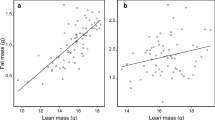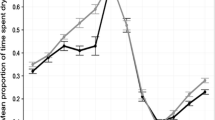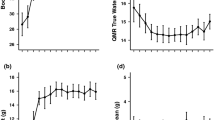Abstract
We conducted the first validation of the deuterium dilution method as a nonlethal technique for estimating the body composition of a shorebird during fall staging as birds fatten in preparation for their migration. For this validation, we captured male (n = 12) and female (n = 8) American Woodcock (Scolopax minor) in the fall of 2018 and 2019 in southern New England, USA. We developed predictive models for estimating body composition of woodcock given each bird’s body mass and deuterium space, a proxy for total body water space, estimated using the deuterium dilution method. Accuracy and precision of these predictive models were assessed by comparing the model predictions with directly measured body composition. The top models predicted whole-body lean and fat mass with a relative error of 1.37% and 11.26%, respectively. In comparison, conventionally used morphology-based condition indices were poor predictors of fat mass in fall-staging woodcock. We applied this method to accurately estimate body composition dynamics of woodcock during fall staging, a period of fattening in the annual cycle that is pertinent to subsequent migratory movements, phenology, survival, and habitat management for woodcock. This nonlethal technique also has broad applicability to other migratory birds that show substantial changes in body composition as they prepare for key life-history events such as migration.
Zusammenfassung
Körperzusammensetzung von Kanadaschnepfen in herbstlichen Rastgebieten: eine Validierung der nichtinvasiven Deuterium-Verdünnungsmethode
Wir führten die erste Validierung der Deuterium-Verdünnungsmethode als nichtletale Technik zur Einschätzung der Körperzusammensetzung bei einer Limikolenart am herbstlichen Rastplatz durch, wenn die Vögel sich in Vorbereitung auf den Zug Fettreserven anlegen. Zur Durchführung dieser Validierung fingen wir Männchen (n = 12) und Weibchen (n = 8) der Kanadaschnepfe Scolopax minor im Herbst 2018 und 2019 im südlichen Neuengland, USA. Wir entwickelten Vorhersagemodelle zur Einschätzung der Körperzusammensetzung der Kanadaschnepfen anhand von Körpermasse und Deuteriumanteil eines jeden Vogels; letzteres diente als stellvertretendes Maß für den Gesamtwassergehalt des Körpers und wurde mittels der Deuterium-Verdünnungsmethode geschätzt. Genauigkeit und Präzision dieser Vorhersagemodelle wurden durch Vergleich der Modellvorhersagen mit der direkt gemessenen Körperzusammensetzung bewertet. Die besten Modelle sagten die Fett- und Magermasse des Körpers mit einem relativen Fehler von 1,37% beziehungsweise 11,26% voraus. Verglichen hiermit lieferten konventionelle morphologische Konditionsindizes nur schlechte Vorhersagen der Fettmasse der Kanadaschnepfen an herbstlichen Rast- und Sammelplätzen. Die Anwendung dieser Methode ermöglichte die korrekte Einschätzung der Körperkonditionsdynamik von Kanadaschnepfen während der herbstlichen Rast- und Sammelphase, einer Zeit im Jahreszyklus, während der Fettreserven gebildet werden und die daher relevant für spätere Zugbewegungen, Phänologie und Überlebensraten sowie das Habitatmanagement für die Kanadaschnepfe ist. Diese nicht-letale Technik hat außerdem ein breites Anwendungspotenzial bei anderen Zugvögeln, bei denen starken Veränderungen in der Körperzusammensetzung in Vorbereitung auf wichtige biologische Ereignisse, wie zum Beispiel den Zug, auftreten.



Similar content being viewed by others
Data availability
Data are available in dryad. https://datadryad.org/stash/share/T46JIJrrCeX9T8poGIJtFF8knjQ2QFzDmhc5ocGyHKg.
Code availability
Code will be made available upon acceptance.
References
Aharon-Rotman Y, Gosbell K, Minton C, Klaassen M (2016) Why fly the extra mile? Latitudinal trend in migratory fuel deposition rate as driver of trans-equatorial long-distance migration. Ecol Evol 6:6616–6624. https://doi.org/10.1002/ece3.2388
Alisauskas RT, Ankney CD (1992) The cost of egg laying and its relationship to nutrient reserves in waterfowl. In: Batt BDJ, Afton AD, Anderson MG, Ankney CD, Johnson DH, Kadlec JA, Krapu GL (eds) Ecology and management of breeding waterfowl. University of Minnesota Press, Minneapolis, pp 30–61
Battley PF, Dietz MW, Piersma T et al (2001) Is long-distance bird flight equivalent to a high-energy fast? Body composition changes in freely migrating and captive fasting great knots. Physiol Biochem Zool 74:435–449. https://doi.org/10.1086/320432
Beuth JM, Paton PWC, Osenkowski JE, McWilliams SR (2016) Validating the deuterium dilution method to measure body composition of common eider. Wildl Soc Bull 40:456–463. https://doi.org/10.1002/wsb.667
Blem CR (1990) Avian energy storage. In: Power M (ed) Current ornithology. Plenum Press, New York, pp 59–113
Bruggink JG, Oppelt EJ, Doherty KE et al (2013) Fall survival of American woodcock in the western Great Lakes Region. J Wildl Manage 77:1021–1030. https://doi.org/10.1002/jwmg.547
Buler JJ, Lyon RJ, Smolinsky JA et al (2017) Body mass and wing shape explain variability in broad-scale bird species distributions of migratory passerines along an ecological barrier during stopover. Oecologia 185:205–212. https://doi.org/10.1007/s00442-017-3936-y
Connors PG (1984) Ecology of shorebirds in the Alaskan Beaufort littoral zone. In: Barnes PW, Shell DM, Reimnitz E (eds) The Alaskan Beaufort Sea: ecosystems and environments. Academic Press, New York, pp 403–416
Coplen TB, Hopple JA, Böhlke JK, Peiser HS, Rieder SE, Krouse HR, Rosman KJR, Ding T, Vocke Jr. RD, Révész KM, Lamberty A, Taylor P, De Bièvre P (2002) Compilation of minimum and maximum isotope ratios of selected elements in naturally occurring terrestrial materials and reagents. U.S. Geological Survey Water-Resources Investigations Report 01-4222
Churchwell RT, Kendall S, Brown SC et al (2018) The first hop: use of Beaufort Sea deltas by hatch-year semipalmated sandpipers. Estuaries Coasts 41:280–292. https://doi.org/10.1007/s12237-017-0272-8
Deppe JL, Ward MP, Bolus RT et al (2015) Fat, weather, and date affect migratory songbirds’ departure decisions, routes, and time it takes to cross the Gulf of Mexico. Proc Natl Acad Sci 112:6331–6338. https://doi.org/10.1073/pnas.1503381112
Dobush GR, Davison C, Krementz DG (1985) The effect of apparatus, extraction time, and solvent type on lipid extraction of snow geese. Can J Zool 63:1917–1920. https://doi.org/10.1139/z85-285
Docherty DE, Converse KA, Hansen WR, Norman GW (1994) American woodcock (Scolopax minor) mortality associated with a reovirus. Avian Dis 38:899–904. https://doi.org/10.2307/1592132
Doherty KE, Andersen DE, Meunier J et al (2010) Foraging location quality as a predictor of fidelity to a diurnal site for adult female American woodcock Scolopax minor. Wildlife Biol 16:379–388. https://doi.org/10.2981/09-100
Eichhorn G, Visser GH (2008) Evaluation of the deuterium dilution method to estimate body composition in the Barnacle Goose: accuracy and minimum equilibration time. Physiol Biochem Zool 81:508–518. https://doi.org/10.1086/588170
Eichhorn G, van der Jeugd HP, Meijer HAJ, Drent RH (2010) Fueling incubation: differential use of body stores in arctic- and temperate-breeding Barnacle Geese (Branta leucopsis). Auk 127:162–172. https://doi.org/10.1525/auk.2009.09057
Ellis HI, Jehl JR (1991) Total body water and body composition in phalaropes and other birds. Physiol Zool 64:973–984. https://doi.org/10.1086/physzool.64.4.30157952
Graham, CL (2020) The influence of pre-migratory body composition and habitat quality on fall migration in the American Woodcock (Scolopax minor). M.Sc Thesis. University of Rhode Island, Kingston
Helms CW, Drury WH (1960) Winter and migratory weight and fat field studies on some North American buntings. Bird-Banding 31:1. https://doi.org/10.2307/4510793
Helseth A, Lindström Å, Stervander M (2005) Southward migration and fuel deposition of Red Knots Calidris canutus. Ardea 93:213–224
Karasov WH, Han LR, Munger JC (1988) Measurement of 2H2O by IR absorbance in doubly labeled H2O studies of energy expenditure. Am J Physiol 255:R174–R177
Karasov WH, Pinshow B (1998) Changes in lean mass and in organs of nutrient assimilation in a long-distance passerine migrant at a springtime stopover site. Physiol Zool 71:435–448. https://doi.org/10.1086/515428
Klaassen M, Hoye BJ, Nolet BA, Buttemer WA (2012) Ecophysiology of avian migration in the face of current global hazards. Philos Trans R Soc B Biol Sci 367:1719–1732
Kuhn M (2008) Building predictive models in R using the caret package. J Stat Softw 28:1–26. https://doi.org/10.18637/jss.v028.i05
Labocha MK, Hayes JP (2012) Morphometric indices of body condition in birds: a review. J Ornithol 153:1–22. https://doi.org/10.1007/s10336-011-0706-1
Leinaas HP, Ambrose WG (1999) Decision between small and large prey: reduced energy acquisition by pre-migratory purple sandpipers, Calidris maritima, on Svalbard. Polar Biol 22:264–270. https://doi.org/10.1007/s003000050419
Lindström Å, Gill RE, Jamieson SE et al (2011) A puzzling migratory detour: are fueling conditions in Alaska driving the movement of juvenile sharp-tailed sandpipers? Condor 113:129–139. https://doi.org/10.1525/cond.2011.090171
Lyons JE, Haig SM (1995) Fat content and stopover ecology of spring migrant Semipalmated Sandpipers in South Carolina. Condor 97:427–437
Maillet D, Weber JM (2006) Performance-enhancing role of dietary fatty acids in a long-distance migrant shorebird: the semipalmated sandpiper. J Exp Biol 209:2686–2695. https://doi.org/10.1242/jeb.02299
McAuley DG, Longcore JR, Clugston DA et al (2005) Effects of hunting on survival of American Woodcock in The Northeast. J Wildl Manage 69:1565–1577. https://doi.org/10.2193/0022-541X(2005)69[1565:EOHOSO]2.0.CO;2
McWilliams SR, Whitman M (2013) Non-destructive techniques to assess body composition of birds: a review and validation study. J Ornithol 154:597–618. https://doi.org/10.1007/s10336-013-0946-3
Mendall HL, Aldous CM (1943) The ecology and management of the American woodcock. Maine Cooperative Wildlife Research Unit. University of Maine, Orono
Mercier FM (1985) Fat reserves and migration of Red-necked Phalaropes (Phalaropus lobatus) in the Quoddy region, New Brunswick, Canada. Can J Zool 63:2810–2816. https://doi.org/10.1139/z85-420
Mitchell GW, Guglielmo CG, Wheelwright NT, Freeman-Gallant CR, Norris DR (2011) Early life events carry over to influence pre-migratory condition in a free-living songbird. PLoS ONE 6:e28838
Moore FR, Yong W (1991) Evidence of food-based competition among passerine migrants during stopover. Behav Ecol Sociobiol 28:85–90. https://doi.org/10.1007/BF00180984
Morton JM, Kirkpatrick RL, Smith EP (1991) Comments on estimating total body lipids from measures of lean mass. Condor 93:463–465. https://doi.org/10.2307/1368970
Muggeo VM (2008) Segmented: an R package to fit regression models with broken-line relationships. R News 8:20–25
Myatt NA, Krementz DG (2007) Fall migration and habitat use of American Woodcock in the Central United States. J Wildl Manage 71:1197–1205. https://doi.org/10.2193/2006-154
Nagy KA (1983) The doubly labeled water (3HH18O) method: a guide to its use. UCLA Publication no 12-1417. UCLA, Los Angeles, CA
Owen RB Jr, Krohn WB (1973) Molt patterns and weight changes of the American Woodcock. Wilson Bull 85:31–41
Olden JD, Jackson DA (2000) Torturing data for the sake of generality: how valid are our regression models? Ecoscience 7:501–510
Parker H, Holm H (1990) Patterns of nutrient and energy expenditure in female common eiders nesting in the high arctic. Auk 107:660–668
Petit DR (2000) Habitat use by landbirds along nearctic-neotropical migration routes: implications for conservation of stopover habitats. Stud Avian Biol 20:15–33
Piersma T, Van Brederode NE (1990) The estimation of fat reserves in coastal waders before their departure from northwest Africa in spring. Ardea 78:221–236
Quinn JT, Hamilton DJ (2012) Variation in diet of Semipalmated Sandpipers (Calidris pusilla) during stopover in the upper Bay of Fundy, Canada. Can J Zool 90:1181–1190. https://doi.org/10.1139/Z2012-086
R Development Core Team (2017) R: a language and environment for statistical computing. R Foundation for Statistical Computing, Vienna
Rae LF, Mitchell GW, Mauck RA, Guglielmo CG, Norris DR (2009) Radio transmitters do not affect the body condition of Savannah Sparrows during the fall premigratory period. J Field Ornithol 80:419–426
Seewagen CL, Guglielmo CG (2011) Quantitative magnetic resonance analysis and a morphometric predictive model reveal lean body mass changes in migrating Nearctic-Neotropical passerines. J Comp Physiol B 181:413–421. https://doi.org/10.1007/s00360-010-0534-2
Seewagen CL, Slayton EJ (2008) Mass changes of migratory landbirds during stopovers in a New York City park. Wilson J Ornithol 120:296–303. https://doi.org/10.1676/07-087.1
Seewagen CL, Sheppard CD, Slayton EJ, Guglielmo CG (2011) Plasma metabolites and mass changes of migratory landbirds indicate adequate stopover refueling in a heavily urbanized landscape. Condor 113:284–297. https://doi.org/10.1525/cond.2011.100136
Sepik GF, McAuley DG, Longcore JR (1993) Critical review of the current knowledge of the biology of the American Woodcock and its management on the breeding grounds. In: Sepik GF, Longcore JR (eds) Proceedings eigth woodcock symposium. pp 98–104
Servello F, Hellgren EC, McWilliams SR (2005) Techniques for wildlife nutritional research. In: Braun E (ed) Research and management techniques for wildlife and habitat. The Wildlife Society, Washington, pp 554–590
Sheldon WG (1967) The book of American Woodcock. University of Massachusetts Press, Amherst
Skagen SK, Knopf FL, Cade BS (1993) Estimation of lipids and lean mass of migrating sandpipers. Condor 95:944–956
Speakman JR, Visser GH, Ward S, Krol E (2001) The isotope dilution method for the evaluation of body composition. In: Speakman JR (ed) Body composition analysis of animals: a handbook of non-destructive methods. Cambridge University Press, Cambridge, pp 56–98
Stoleson SH (2013) Condition varies with habitat choice in postbreeding forest birds. Auk 130:417–428. https://doi.org/10.1525/auk.2013.12214
Stutchbury BJM, Gow EA, Done T et al (2011) Effects of post-breeding moult and energetic condition on timing of songbird migration into the tropics. Proc R Soc B Biol Sci 278:131–137. https://doi.org/10.1098/rspb.2010.1220
Tulp I, Schekkerman H, Klaassen RHG et al (2009) Body condition of shorebirds upon arrival at their Siberian breeding grounds. Polar Biol 32:481–491. https://doi.org/10.1007/s00300-008-0543-8
Vitz AC, Rodewald AD (2006) Can regenerating clearcuts benefit mature-forest songbirds? An examination of post-breeding ecology. Biol Conserv 127:477–486. https://doi.org/10.1016/j.biocon.2005.09.011
Williams TD, Guglielmo CG, Martyniuk CJ (1999) Plasma lipid metabolites provide information on mass change over several days in captive Western Sandpipers. Auk 116:994–1000. https://doi.org/10.2307/4089679
Acknowledgements
We thank the following for their knowledgeable advice and assistance in the field and lab: C. Slezak, P. Woodward, C. Cooper-Mullin, K. Demoranville, W. Carter, A Frawley, L Corcoran, S. Clode, R. McKinney, M. Muller, and A. Huth. We thank Dr. C. Lee for the use of his Food Science and Nutrition Laboratory at URI in which we conducted some of the carcass analyses. A. Huth provided additional forms of indispensable logistical support, advice, and assistance. This is contribution number XXXX of the Rhode Island Agricultural Experiment Station.
Funding
This study was funded by the Rhode Island Department of Environmental Management via the USFWS Wildlife and Sport Fisheries Restoration to RI project W23R (Job 1–12), the Rhode Island Agricultural Experiment Station, and the College of Environment and Life Sciences at the University of Rhode Island (URI) to SRM. Agricultural Experiment Statio, (Grant number: RI0017-MS-981).
Author information
Authors and Affiliations
Contributions
SRM and CLG developed and designed the research. CLG conducted the research. CLG wrote the paper with substantial input from SRM. CLG analyzed the data. SRM contributed substantial resources.
Corresponding author
Ethics declarations
Conflict of interest
The authors declare that they have no conflict of interest.
Ethical approval
All birds were captured under a master bander permit from the U.S. Geological Survey Bird Banding Laboratory, and all research activities were approved by the University of Rhode Island Institutional Animal Care and Use Committee (#AN10-02-017). This research was conducted in compliance with the Guidelines to the Use of Wild Birds in Research.
Additional information
Communicated by C. G. Guglielmo.
Publisher's Note
Springer Nature remains neutral with regard to jurisdictional claims in published maps and institutional affiliations.
Supplementary Information
Below is the link to the electronic supplementary material.
Rights and permissions
About this article
Cite this article
Graham, C.L., McWilliams, S.R. Body composition of American Woodcock during fall staging: a validation of the non-invasive deuterium dilution method. J Ornithol 163, 213–222 (2022). https://doi.org/10.1007/s10336-021-01929-2
Received:
Revised:
Accepted:
Published:
Issue Date:
DOI: https://doi.org/10.1007/s10336-021-01929-2




